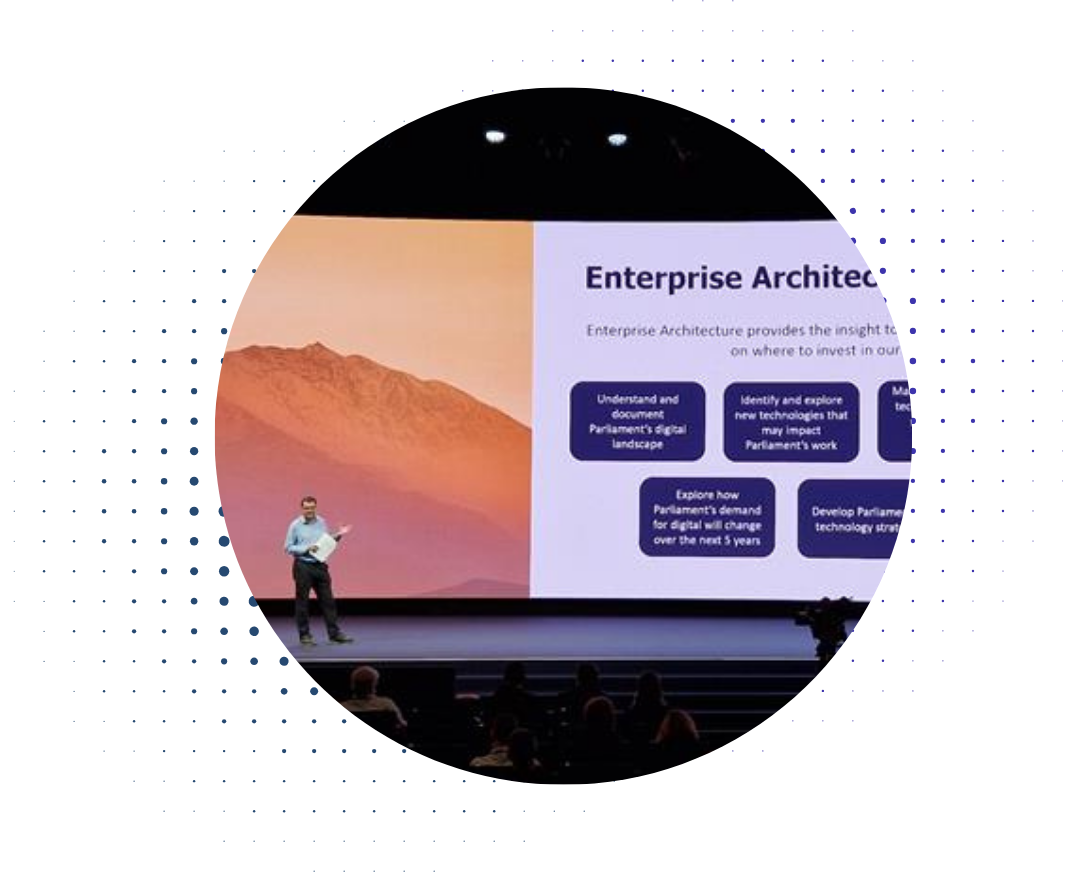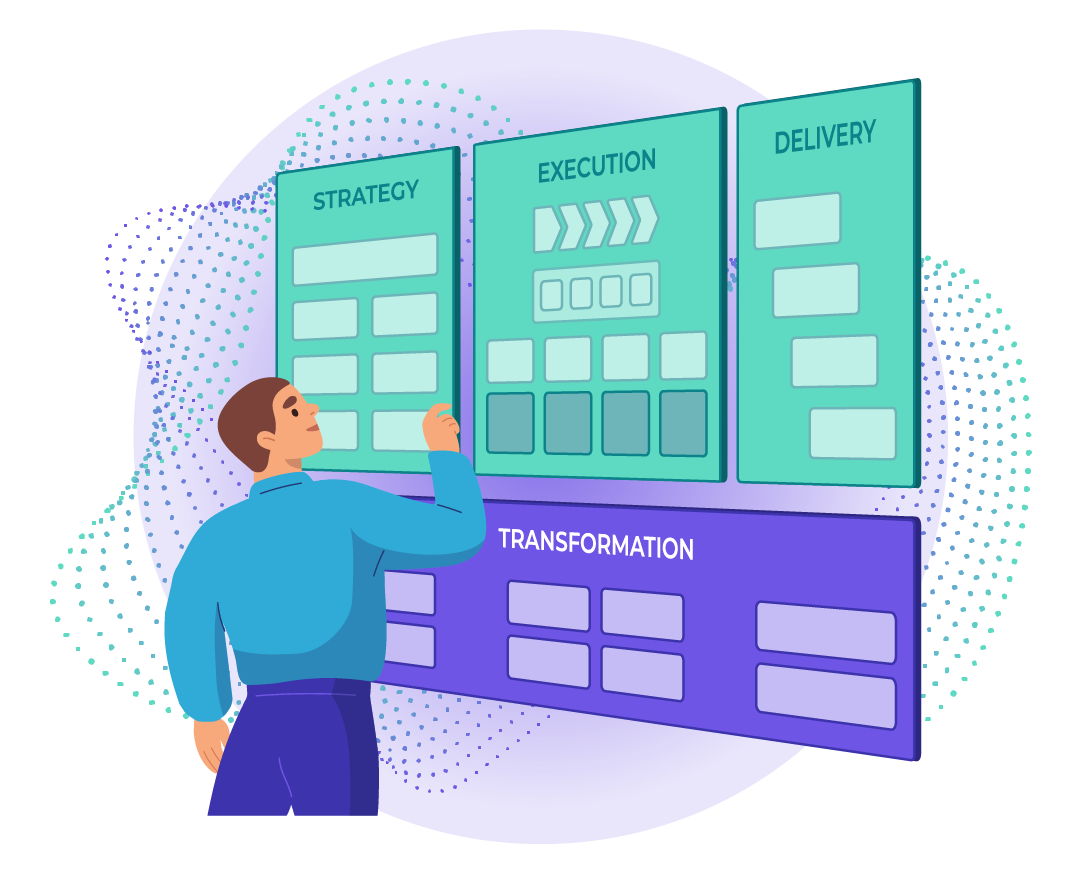The UK Parliament is an institution steeped in tradition, history, and ceremony. But behind the scenes, it’s embracing digital transformation to meet the demands of a rapidly changing world. At the Gartner IT Symposium/Xpo in Barcelona, Rupert Hay-Campbell, Head of Architecture at the Parliamentary Digital Service, shared how enterprise architecture is playing a pivotal role in modernizing Parliament for a digital future.
Parliament’s digital landscape: A complex ecosystem
Parliament’s use of digital technology is vast and varied, supporting everything from procedural business to public engagement. Here’s a snapshot of its digital ecosystem:
- Around 250 applications: From bespoke tools to off-the-shelf solutions, these applications primarily support Parliament’s procedural activities.
- Large web presence: Parliament’s websites serve as a vital connection point for the public.
- Cloud-first approach: With Microsoft 365 deployed and SaaS back-office systems in place, Parliament is leveraging modern technologies to stay agile.
- Bespoke applications: Many systems are tailored to Parliament’s unique needs, reflecting its centuries-old traditions.
This intricate digital landscape serves over 12,500 internal users, including MPs, Lords, staff, and the Parliamentary Digital Service team. Yet, the challenge lies in ensuring these technologies evolve to meet growing demands while maintaining security and resilience.
The role of ritual and ceremony in technology adoption
One of the most fascinating aspects of Parliament’s digital transformation is how ritual and ceremony influence technology adoption. Rupert highlighted this unique dynamic: "There aren’t many workplaces where someone in uniform and wearing a sword is part of the main workspace!"
While this might seem unusual, it’s a reminder that every organization has its own culture and traditions that shape how new technologies are embraced. In Parliament, these rituals make the adoption of certain technologies more visible – but the principle applies universally. Understanding organizational culture is key to driving successful transformation.
Challenges in supporting a digital Parliament
Parliament’s members – MPs and Lords – pose unique challenges for the digital team. Unlike employees in a typical organization, MPs can choose which services they use and purchase their own tools. With nearly 650 physical office locations spread across the country, Parliament’s digital services must be flexible and robust.
Additionally, the rise of social media has introduced new security challenges for MPs. Balancing accessibility with security is a critical focus for the Parliamentary Digital Service.
Digital drivers: What’s shaping Parliament’s future?
Rupert outlined several key drivers behind Parliament’s digital transformation:
- Modernizing technology: Moving away from project-based funding models to product-centric delivery.
- Dealing with legacy systems: Identifying opportunities to modernize outdated technologies.
- Exploiting data: Leveraging insights to improve decision-making.
- Building resilience: Ensuring digital services can withstand disruption.
- Improving support for MPs and Lords: Enhancing the tools and services available to members.
Together, these digital drivers form the foundation of Parliament’s modernization strategy, enabling it to deliver meaningful outcomes.
Value streams: Connecting digital transformation to business outcomes
Value streams are at the core of Parliament’s approach to digital transformation, ensuring that every investment and initiative is tied directly to its overarching goals. These streams represent the key areas where Parliament delivers value to its stakeholders, including members, staff, and the public.
Here are the main value streams driving Parliament’s transformation:
- Engaging with the public: Digital tools support public engagement, enabling citizens to stay informed and interact with Parliament’s work.
- Supporting proceedings: Bespoke applications and digital systems streamline the procedural business of Parliament, ensuring debates, votes, and committee meetings run smoothly.
- Using data and information: Data is a powerful asset for Parliament, enabling informed decision-making and driving innovation across teams.
- Managing the estate: Parliament’s physical infrastructure is vast and complex. Digital technologies play a key role in managing and maintaining its buildings, facilities, and IT estate.
- Providing corporate services: Back-office systems, including SaaS solutions, support the day-to-day operations of Parliament, from HR to finance.
- Keeping Parliament secure: Security is paramount, especially in the digital age. The Parliamentary Digital Service must identify risks and implement robust measures to protect Parliament’s systems and data.
- Enabling members: MPs and Lords rely on flexible digital services tailored to their unique needs, so the team needs to ensure these services are accessible, secure, and aligned with their work.
By focusing on these value streams, the Parliamentary Digital Service can ensure its technology strategy supports its mission effectively.
Enterprise architecture: The backbone of transformation
Enterprise architecture is at the heart of Parliament’s digital strategy, providing the insight to act on its digital drivers and value streams, and make informed decisions about where to invest, for example:
- Technical governance: This encompasses managing Parliament’s technical principles, standards, and reference architectures, ensuring consistency and alignment across its digital systems.
- Understanding the digital landscape: Refers to documenting Parliament’s applications, technologies, and dependencies to gain a comprehensive view of its digital ecosystem.
- Exploring emerging technologies: Covers identifying and assessing new technologies, such as AI, that could impact Parliament’s work and operations.
- Developing roadmaps: Includes creating architectural plans and strategies to guide Parliament’s long-term technology evolution and align with its future digital demands.
Key artifacts driving decision-making
To support its transformation and enterprise architecture practice, the Parliament Digital Service relies on target architectures and roadmaps for each value stream. To create those, it uses several critical artifacts:
- Business capability models: These show how Parliament works, how it achieves its purpose, and how digital tools enable this.
- Application and technology registers: Mapping the digital landscape to identify risks and opportunities.
- Heatmaps: Visual tools that highlight risks, legacy technologies, and business-critical systems.
- Impact explorer: A tool for understanding relationships between capabilities, applications, and technologies.
These artifacts enable Parliament to prioritize investments and ensure its digital services are fit for the future.
Conclusion: A systematic approach to transformation
The UK Parliament’s journey to modernization is a testament to the power of enterprise architecture. By breaking down the organization’s digital landscape into digital drivers, value streams, and business capabilities, the Parliamentary Digital Service can systematically plan investments, address legacy technology, and embrace emerging trends, ensuring its digital services meet future demand.
Rupert summed it up perfectly: "Understanding the digital landscape in Parliament is challenging but vital. Enterprise architecture plays a key role in bringing everything together to ensure we make the right investments and meet the needs of our users."
While the UK Parliament’s challenges are unique, its approach to digital transformation offers valuable lessons for other organizations. Whether you’re navigating legacy systems or adopting new technologies, enterprise architecture provides the framework to align strategy, technology, and culture.
UK Parliament has trusted OrbusInfinity since 2021 to navigate and manage its digital transformation strategy. Discover how OrbusInfinity can help your organization achieve its goals with clarity and confidence. Book a demo today to see the platform in action.






